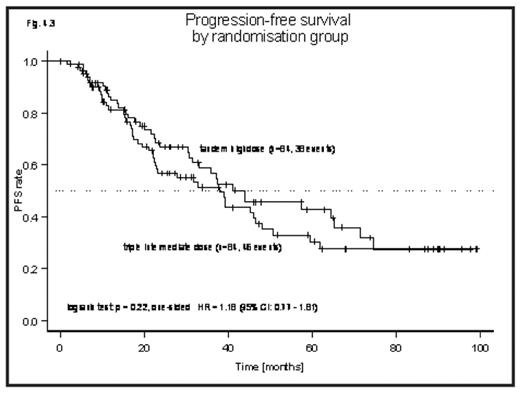Abstract
Previous studies showed a survival advantage of double over single transplantation in proportion of patients. In this study we aimed to explore whether triple transplantation with intermediate melphalan 100mg/m2 (M100) yields at least similar treatment results with less toxicity than double transplantation with melphalan 200mg/m2 (M200). 219 Patients were entered in the study and started on 3 cycles of VAD induction therapy followed by IEV (ifosfamide (2g/m2)-etoposide (150mg/m2), d1-3; epirubicin (50mg/m2) d1) and G-CSF (5mg/kg) from d4 for stem cell priming and collection. Thereafter, 178 patients were randomized to either double or triple transplantation with M200 or M100. Reasons for non-randomization were PD (n=21), toxic side effects during induction or insufficient mobilization (n=9), withdrawal of consent (n=3), too early (n=1), death (n=1), second neoplasia (n=1), protocol violation (n=2), other (n=3). Patients achieving better than PD had subsequently been randomized to prednisolone plus interferon-a2b (Schering Plough) 3MU TIW or to interferon only maintenance therapy. Median age was 58 years (range: 27–71 years, n=172). DS stage I: 7%, stage II: 18%, stage III: 75%, M-component: IgG: 60%, IgA: 24%, IgD: 1%, IgM: 1%, light chain: 11%, non-secretory:1%. QoL was assessed with the EORTC QLQ C30 instrument. Chi2 test for trend was used for comparison of response and survival endpoints were estimated by the Kaplan-Meier product limit method. Median follow up is 34 months. Response rates in 186 patients evaluable for response after VAD (≥ 2 cycles of VAD) were: CR: 10%, PR: 58%, SD: 21% and PD: 11%. Median time from start of VAD to start of transplantation was 141 in the double and 144 days in the triple transplantation arm. Response rates after transplantation did not differ between pts treated with double or triple transplantation (CR: 41% vs. 41%, PR: 50% vs. 49%, SD 8% vs. 8%, PD: 1% vs. 3%, p=0.91. Median PFS for both groups combined was 39 mos, but showed a tendency for shorter PFS in pts on triple transplantation (median 44 mos. vs. 38 mos; HR 1.18, 95% CI: 0.77–1.81, p=0.22). Median OS has not been reached as yet, but did not differ between both groups with 3-year rates of 85% and 81%, respectively, and a HR of 1.01. Except for more cases of grade 1 and 2 anemia in the triple transplantation arm, hematological toxicity was similar in both groups. There was a tendency for more grade 2–3 mucositis and grade 3–4 vomiting, nausea in the double transplantation group. In conclusion, triple transplantation with intermediate dose M resulted in similar response rates, slightly shorter PFS but similar OS and was associated with less mucositis and slightly less vomiting, and nausea.
Disclosures: No relevant conflicts of interest to declare.
Author notes
Corresponding author


This feature is available to Subscribers Only
Sign In or Create an Account Close Modal